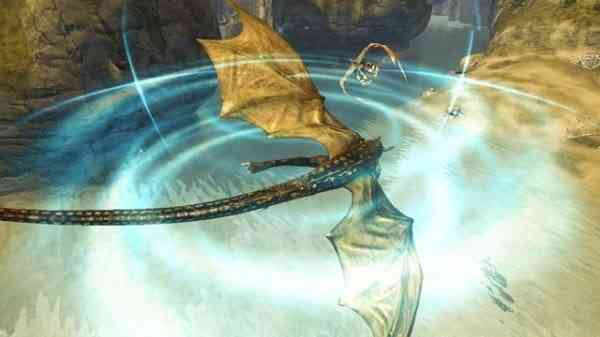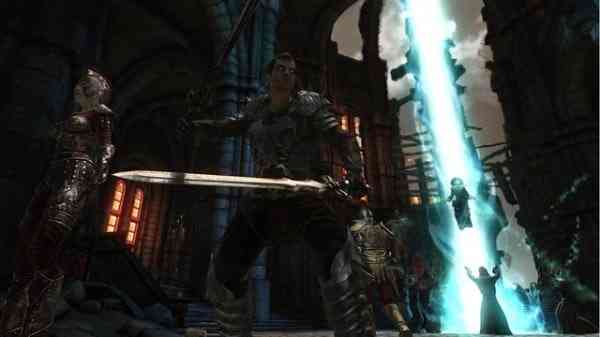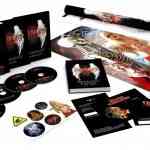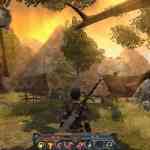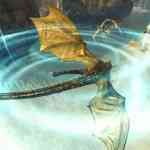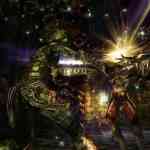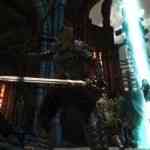I have to admit, I really love it when Publishers bundle games together to make each precious dollar I earn go a bit further. Larian Studios does exactly that with “Divinity Anthology”. This game packages together two of Larian’s first games (remastered for higher screen resolutions and support for Windows 7), and a brand new game called Divinity II: Developer’s Cut that promises to let the player tinker with the inner workings of the game itself. The three games together pack a lot of content but is it worth the asking price?
The first game in the anthology is Divine Divinity, which originally came out in 2002. The story starts out with our hero travelling the lands in search of adventure but is overwhelmed by monsters in a forest and is eventually knocked out. He awakens in a dazed state sometime later in a basement of a healer who happened to come across his path. The healer fills him in on details of evil and madness that has started to sweep across the land and your character agrees to help those in danger and rid the evil, and his quest begins.
When the game starts you create your character by choosing between three different classes – the standard warrior, mage, and survivor class (which seems to be a thief-like class). The character can be male or female, and you can choose a different avatar icon from the few provided. Once you venture out, you discover gameplay is the standard point-and-click variety much like Diablo. Want to lead your character to a certain point on the screen? Just point and click. The same with attacking enemies, except you can hold down the attack button and your character will repeatedly attack or you can just click at your own speed manually until the enemy is dead.
Much like the games combat mechanics, you will point and click to interact with NPCs (which will talk your ears off in some cases). You will be doing a lot of reading in this game with all the branching dialog trees – almost too chatty at times for me. As you make your way through the game and earn experience points, you will eventually level up which will allow you to add new skills and points towards your character’s stats. As with most games of this ilk, there is a lot of loot to discover and you won’t be disappointed. I especially liked how the inventory screens are arranged, with separate areas for weapons, armor, spells, etc. You can physically move the items around freely and organise them on the screen in a virtual box of sorts.
The second game in the anthology titled Beyond Divinity was released in 2004. Its story starts out with your human character escaping a demon-run jail and is now being hunted by the demon guard who was supposed to be guarding you. Freedom is short-lived as the guard catches you and brings you back but the demon’s bosses are not happy. The guard has his soul bound to the human he just recaptured, so if the human dies the demon guard dies, and vice versa. So the demon guard sets out with the human, seeking someone to break the spell binding them together.
You will find a lot of the gameplay and interaction is very similar to the first game. However, controlling two characters instead of one introduces some large gameplay changes. You can control each character independently, or both at the same time with either the human in front or the demon. This makes for some interesting gameplay and strategy in terms of how you deal with enemies and puzzles.
The second game does suffer from chatty NPC characters much like the first, but has a deeper character creation setup, allowing you to tinker with your stats instead of taking a preset one. You still have the standard classes from the first game, but you can alter how your character looks in size, hair color and face. You can even choose to have your character be a child which was different.
The last game (and the newest in the series) is Divinity II: Developer’s Cut. Here the developers went with a more modern style of play, where your view is from a third-person over-the-shoulder perspective. The character controls fairly well like this, but I found the camera at times had trouble keeping up with me during combat. Before you create your character you are given two mission choices. The first one is called “Ego Draconis”. Here your goal is to become a dragon slayer and fight the beasts off before they destroy your homeland. You first start off creating your character to your liking, creating either a male or female avatar with plenty of different hairstyles and colours to choose from. You can even select between various voice types. Once you are in the game the first city you encounter is more of a tutorial on how things work. Here you will choose a class, pick up some basic supplies and learn the laws of the land.
You also learn a neat skill called Mind Reading. With it you can learn information that will help you persuade people, find side quests, or get discounts at shops. However, this skill costs some of your gained experience points and the cost varies from one NPC to another. Once again when dealing NPCs, they can be very chatty sometimes with several minutes of dialog which went on way too long.
Combat is a lot more fun and rewarding in this new game, with a wide new selection of special moves to choose from as you gain experience points from doing side quests and killing off enemies. Yet like I mentioned before, I found the camera to be a little slow keeping up and I found myself trying to correct it manually so the cheap hits would not happen. Despite that, it is still fun swinging a huge sword and taking down groups of enemies.
The second storyline choice is called “Flames of Vengeance”. You start out the game already as a dragon slayer, at level 35, and with a lot of gold already in your purse. You have been summoned by a demon who wants you to help ward off an invading force on a city, but the demon has his own evil plan and is using you as his tool. At the start of this story you are given the same choices creating your character as you did in the first except you have plenty of skill points to unlock a huge amount of skills to start with.
That’s not all this game has to offer. Have a desire to run around as a chicken in the game? Have infinite money or experience? Well, now you can by starting the game in Developer’s mode. In this mode, pressing the F11 key presents you with a screen that has a whole slew of choices. They range from giving yourself as much gold, items, and experience as you want, the ability to morph yourself into various creatures and animals, or teleport yourself to any region or area in the world. They also give you the good ol’ “God mode”, so you can kick ass all the way through the game and story without worry of dying.
Also included in the final game is the Treasure Vault. Here you will find concept art, music, and movies from the game. You will also find developer notes on the creation and development of these games which I found rather cool to read as it’s not too often you find that offered in a game.
Visually, the first two games look identical and remind me of Diablo 2 because of the top down angled perspective. They now offer higher resolutions than their original releases had, which is nice but I found at the higher settings, it became harder to make out small objects and read text on the screen which hadn’t been scaled up to compensate. Often I resorted to slowly dragging the mouse cursor around the screen trying to find that one object I needed to progress the story. Character and monster designs work well with this game, but neither offers anything that would stand out in this day and age.
The third game is a definite graphical upgrade with large, lush, and open areas to run around in. It reminded me of a more cartoony Elder Scrolls game. Sometimes I’d just stop and admire the scenery. Characters and NPCs you interact with are well animated and have enough variety to not to seem like they just took the same model and colored them differently.
The Audio in the games is a bit of a mixed bag. The musical score of all three games is beautiful, and I’d say was worth listening to on their own. Sound effects across the first two games are what you expect from games of this age but the third game’s sound effects are masterfully done. The voice acting in the first two games had me laughing and cringing at times. Some of the voices are delivered just too over-the-top. Even stranger, in the first game you have male voice actors voicing female roles. I couldn’t help to think I was listening to a Monty Python sketch at one point. I was glad to see in the third game the quality of the voice actors went up a lot, so you didn’t have to worry to what you were going to be subjected to, and instead feel more immersed in the world.
In the end, is this Anthology worth the investment? Well, given the massive amount of content and gameplay you get in this package Divinity Anthology is pretty good bang for the buck. Fans of old school Diablo style dungeon crawlers and even those fans of third person action RPG’s should enjoy Divinity Anthology. Granted, there is nothing truly innovative brought to the table; however, the core gameplay is entertaining and there is no denying Divinity Anthology offers up well over a hundred hours of quality gameplay for a mere 30 bucks.

